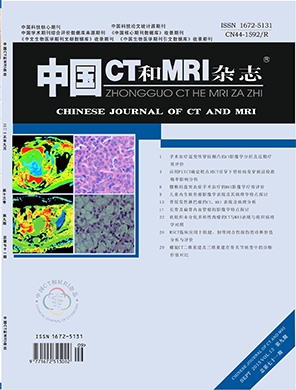摘要
目的研究胃间质瘤(GST)的CT 影像学表现,预测肿瘤的恶性程度。方 法 研究32例经手术或穿刺活检并经病理 证实的GST患者的临床资料及CT表现, 分析肿瘤的大小、形态、部位、边界、 生长方式、密度、强化程度、坏死囊变 及脂肪间隙情况。结果 低度危险肿瘤 12例,中度危险肿瘤12例,高度危险肿 瘤8例。肿瘤的大小、形态、边界、生 长方式、密度、强化程度、坏死囊变及 脂肪间隙情况与危险度的差异具有统计 学意义(P<0.05),而患者的性别、肿瘤 的发病部位与危险度之间无统计学差异 (P>0.05)。结论 CT对胃间质瘤的诊断及 危险度的分级具有重要作用,对临床诊 治具有重要价值。
Objective To study the gastric stromal tumor (GST) performance of the CT imaging, prediction of malignancy tumor. Materials 32 cases confirmed by operation or biopsy and clinical data and CT findings of pathologically proved GST were analyzed, the tumor size, shape, location, boundary, growth pattern, density, degree of enhancement, necrosis and fat clearance. Results 12 cases of low risk tumor, 12 cases of moderate risk tumor, 8 cases of high tumor. Statistically significant size, shape, boundary, the difference of growth pattern, density, degree of enhancement, necrosis and fat clearance and the risk of cancer (P<0.05), but there was no difference between the incidence of and risk sex, tumor patients (P>0.05). Conclusion CT plays an important role in the diagnosis and classification of gastric stromal tumor risk degree, has the important value to the clinical diagnosis and treatment.
【关键词】胃间质瘤;病理;CT
【中图分类号】R735.2;R445.3
【文献标识码】A
【DOI】10.3969/j.issn.1672-5131.2015.09.031
前言
胃间质瘤(gastric stromal tumor, GST)为一种间叶性肿瘤[1], 随着瘤体增大,肿瘤逐渐显现出恶性生物学行为。NIH于2002年根据 GIST大小和核分裂像,将其分为四个等级:极低危险、低度危险、中 度危险和高度危险[2]。
中国CT和MRI杂志
第13卷, 第 9 期
2015年09月

相关文章